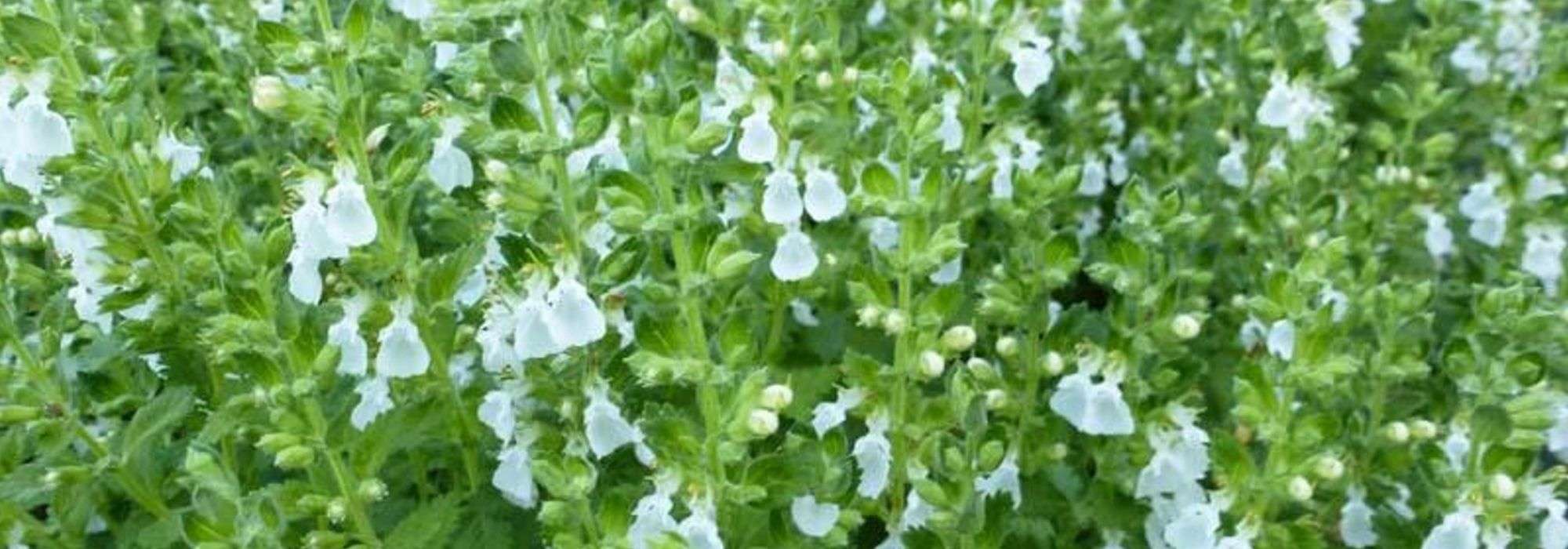
Teucrium, Germander: planting, caring for
Contents
Teucrium in a nutshell
- Teucrium or germander is a perennial or an undershrub valuable for arid and mineral areas of the garden
- Height varies from a few centimetres (small oak germander) to over 1.50 m for Teucrium fruticans or shrubby germander
- Its flowering can be white, pink, blue, and more rarely yellow, occurring in winter, spring, or summer
- Hardy and undemanding, drought-tolerant, it thrives in full sun in very well-drained, poor, and stony soil
- It is easy to shape through pruning and will be perfect for creating hedges, rockeries, and dry borders in dry gardens and coastal areas
A word from our expert
The genus Teucrium includes various species of Mediterranean sub-shrub perennials, among them the Shrubby Germander (Teucrium fruticans) and its stunning variety ‘Azureum’ with blue flowers reaching nearly 2 m in height, as well as lovely shrubs like Teucrium chamaedrys or Wall Germander that do not exceed 30 cm in height. Alongside these more common species in our gardens, one may also encounter Teucrium polium or Woolly Germander with small, evergreen, silvery-grey leaves, as well as Teucrium x lucidrys, which make excellent ground-cover plants for rockeries and borders.
Teucrium are appreciated for their often aromatic foliage, topped with early or summer flowering in white, pink, purple, blue, and more rarely pale yellow.
Rather hardy for a Mediterranean plant, the Germander is not afraid of drought, sea spray, or poor, arid, calcareous soils. It tolerates pruning very well and can be easily shaped into topiary.
Make room for it in the sun, it is a boon in a dry garden!
Description and Botany
“`html
Botanical data
- Latin name Teucrium
- Family Lamiaceae
- Common name Germander
- Flowering March to September depending on species
- Height 0.15 to 2 m
- Exposure Sun
- Soil type Stony (poor and well-draining)
- Hardiness -5°C to -15°C depending on species
Teucrium or Germander belongs to the Lamiaceae family, just like its close relatives the sages, mints, lavenders, and thymes. The genus comprises around a hundred species native to the slopes and rocky areas of the Mediterranean regions of southern Spain, southern Portugal, and Morocco, as well as the arid hills of Iran and the Caucasus. Germanders are divided into spreading species such as Teucrium chamaedrys (the small oak germander) and shrubby species like Teucrium fruticans also known as “Tree Germander” which is the most common in gardens. This species grows spontaneously along our Mediterranean coast where it is actually protected. ‘Azureum’, a teucrium with blue flowers, is one of the prettiest varieties derived from this shrubby Germander.
Among the Teucrium, we also find Teucrium hircanicum or Iranian germander, and Teucrium x lucidrys or Lucydris Germander, a perennial undershrub that is very spreading, to name just the most commonly planted species in our gardens.
The habit and size vary according to species: shrubby and somewhat untidy, it can reach up to 1.40 m, even 2 m in all directions for Teucrium fruticans, upright in clumps about 60 cm high for Teucrium hircanicum, and creeping and very spreading for Teucrium chamaedrys and Teucrium x lucidrys, two species whose height ranges from 15 to 40 cm. Teucrium aroanium, one of the smallest (8 to 10 cm high), makes a perfect groundcover.
The foliage is often evergreen, sometimes semi-evergreen, or even deciduous, depending on the climate, develops on quadrangular stems that are often woody, sometimes cottony, with some germanders forming well-erect, highly branched stems (Teucrium fruticans) and others (Teucrium chamaedrys) spreading slowly via stoloniferous stems that root upon contact with the soil.
The shape, appearance, and colour of the leaves also differ according to species. They are arranged in opposite pairs and decussate, meaning arranged in a cross along the stem. They measure 3 to 5 cm long and are linear, ovate to oblong, or lanceolate, with prominent veins, entire or so strongly crenate that they resemble tiny oak leaves, in the case of the small oak germander, which has earned this undershrub its vernacular name.
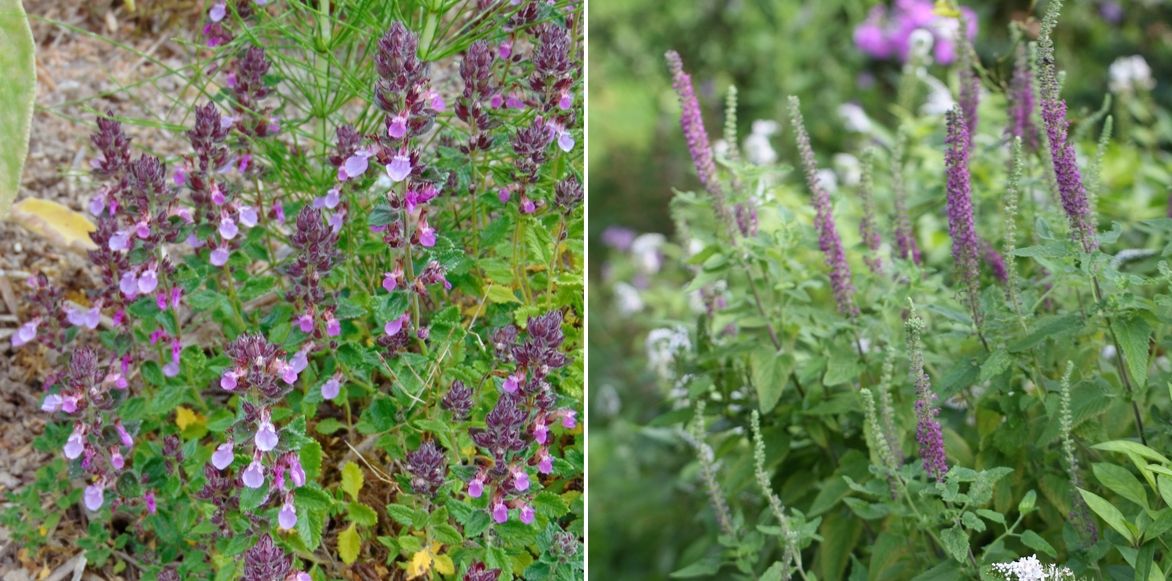
Teucrium chamaedrys / Teucrium hircanicum
Thick, green, and shiny on top in most species, they are covered with a fine down that gives them a bright silvery-grey-green colour in Teucrium fruticans. The underside of the leaves is often covered with a thick white felt or tomentum, very downy. In some, they are slightly aromatic when crushed. The foliage then exudes a scent reminiscent of hay or a somewhat pungent odour.
From this glabrous or pubescent vegetation, both compact yet light, emerge in spring (from February to June, sometimes as early as December in the Mediterranean region) or in summer (from June to September north of the Loire), depending on species and climate, small inflorescences typical of the Lamiaceae. Gathered in groups of 2 to 6, in racemes or spikes on the upper part of the hairy stems, the round, downy flower buds open into bilabiate corollas of 1 cm. These small but numerous flowers, set in a campanulate calyx, are divided into 5 pointed petals fused together forming a single lower lip. The middle lobe is longer. Each houses a bouquet of 4 prominent stamens, two of which are more prominent than the others.
The Teucrium hircanicum is distinguished by its flowering in long violet spikes that can measure up to 20 cm in length.
Each of these delicate small flowers blooms in shades ranging from pure white in Teucrium chamaedrys ‘Alba’ to lilac pink, through the purple red of the Iranian germander, and more rarely yellow (Teucrium polium, Teucrium flavum) while the cultivar ‘Azureum’ stands out with bright blue flowers tinged with lavender.
This delicate flowering, particularly nectariferous and melliferous, blooms for long months and attracts pollinating insects.

Teucrium fruticans (photo Peganum) / Teucrium lucidrys / Teucrium chamaedrys ‘Alba’
Its fruits consist of four achenes containing seeds that can naturalise through spontaneous sowing.
It is a Mediterranean plant that grows in full sun, tolerates poor soils, essential in dry gardens and is capable of withstanding short frosts of around -12°C.
Teucrium, particularly the famous small oak germander, has antiseptic and digestive therapeutic properties, and is also useful for treating rheumatism and headaches. Its young leaves can enhance salads, and it is used to flavour liqueurs such as chartreuse and vermouth with its slightly bitter taste. Its dried flowering tops are consumed as an infusion.
“`
Main species and varieties
In the family of Teucrium, you will have the choice of lovely little groundcovers, robust perennials forming beautiful vigorous clumps 60 to 80 cm tall, and shrub species capable of reaching 2 m in height! Hardiness varies according to the species, as does the shape and colour of the foliage. Cultivars have expanded the colour palette of Teucrium flowers, which originally range from pink to purple.
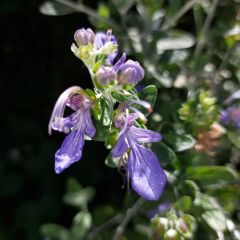
Teucrium fruticans Azureum - Tree Germander
- Flowering time March to September
- Height at maturity 1,20 m
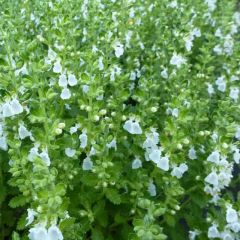
Teucrium chamaedrys Alba - Germander
- Flowering time July to September
- Height at maturity 30 cm
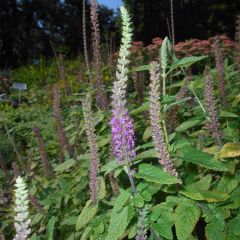
Teucrium hircanicum - Germander
- Flowering time July to September
- Height at maturity 60 cm
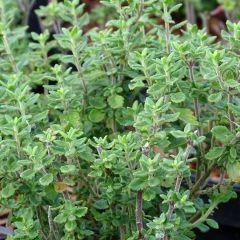
Teucrium x lucidrys
- Flowering time July to October
- Height at maturity 30 cm
Discover other Teucrium
View all →Available in 1 sizes
Available in 0 sizes
Available in 1 sizes
Available in 1 sizes
Available in 2 sizes
Available in 2 sizes
Available in 1 sizes
Available in 1 sizes
Available in 1 sizes
Available in 2 sizes
Planting
Where to Plant Teucrium?
The germander is a Mediterranean plant accustomed to dry, poor, and calcareous soils. It is well-equipped to withstand drought and long, hot, dry summers. Most Teucrium species, however, tolerate cold fairly well and can endure short frosts (down to -10°C to -12°C) once established. The Teucrium fruticans, which is a bit more sensitive (it suffers from cold at -5°C), will thrive better in regions with mild winters; in our coldest and wettest areas, it should be grown in a pot to be wintered away from frost.
It loves full sun, which enhances the silvery colour of the foliage in some species and intensifies its fragrance.
Native to arid regions, it prefers stony, poor, dry, and calcareous soils where it grows best, but it will also accept any good garden soil as long as it is very well-drained: it fears waterlogged soils in winter, as it will be difficult to help it survive the winter under such conditions. In heavy soils, it should be grown on a slope or in a raised bed.
This undershrub or small perennial is a good plant for dry areas where it forms lovely bright green or silvery clumps. It has its place in all natural gardens or as a windbreak in coastal gardens as it is not afraid of sea spray.
The smaller species will grow on dry slopes, on the sides of a rockery, in the crevices of an old stone wall in the most inhospitable areas of the garden, and even in pots.
Shrubby germanders are ideal for free-standing or trimmed hedges, as well as in shrub borders. They are perfectly suited to be trimmed into topiary.
When to Plant Teucrium?
Plant Teucrium in spring from February to May depending on the region when temperatures rise, or in autumn from September to November in warm climates.
How to Plant Teucrium?
In the Ground
For creeping species, allow 5 plants per m². For shrubby germander, 1 plant per m² is sufficient.
- Dig a hole 2 to 4 times the diameter of the root ball
- Loosen the soil well
- Lighten with coarse sand
- Spread a 10 cm layer of gravel at the bottom of the planting hole
- Plant, fill in
- Lightly firm
- Water generously then moderately without flooding the roots
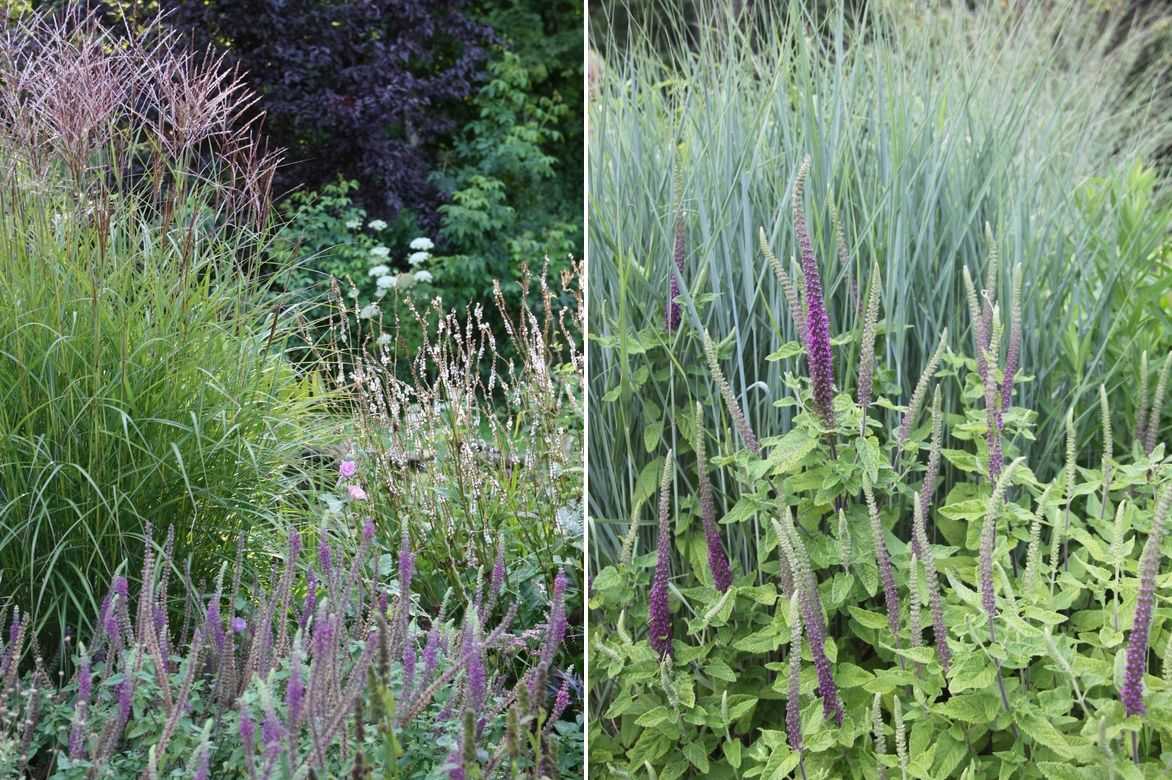
Teucrium hircanicum with grasses
In a Pot
Teucrium can also be grown in pots on the terrace or balcony, to be wintered away from frost in the wettest regions. The substrate must be very well-draining to avoid stagnant moisture at the roots: do not leave water in the saucers.
- Spread a good layer of drainage (gravel or clay balls) at the bottom of the pot
- Plant in a mixture of equal parts sand and potting soil for Mediterranean plants
- Water at planting then without excess
- In cold regions, store the pot for winter and bring it out in fine weather
Maintenance, pruning and care
The teucrium is a truly undemanding plant that requires very little attention and is ideal for a low-maintenance weekend garden. Water for the first two months after planting to encourage rooting, then only during prolonged dry spells, and always sparingly, as it is accustomed to the long, arid summers characteristic of the Mediterranean climate. Once well-rooted, let nature take its course!
Regularly remove faded flowers to encourage the appearance of new ones and extend the flowering period. Allow some flower heads to set seed so you can sow them the following year.
For potted germandrées, ensure more regular watering while always allowing the substrate to dry out well between waterings.
For this undemanding plant, no fertiliser is necessary.
Watch for spontaneous seedlings, which can be numerous; remove them or replant them wherever you wish.
In regions with harsh, wet winters, bring in the more tender teucrium, such as Teucrium fruticans, to protect them from frost and rain, and take them out again as soon as temperatures rise in spring. Repot every two to three years or top-dress annually in spring with compost.
Resistant to diseases, teucrium have no enemies.
Discover more tips for properly maintaining perennials and protecting your plants from the cold.
When and how to prune?
Pruning the Teucrium is the only real maintenance required. It is recommended annually to maintain a nice, bushy habit. Annual prunings at the end of winter and in summer prevent the formation of old wood. If not pruned, the germandrée will readily adopt a scruffy silhouette. It lends itself very well to shaping like boxwood or topiary. We therefore recommend two prunings:
- In spring, trim the largest of the young shoots with shears to even out the clump, cut fairly short, and remove all dead wood.
- Just after flowering, remove faded flowers with a clean-up pruning by cutting just below the flower head.
Every four years, rejuvenate the oldest plants by cutting them back severely to three buds from the stump; they will regrow beautifully!
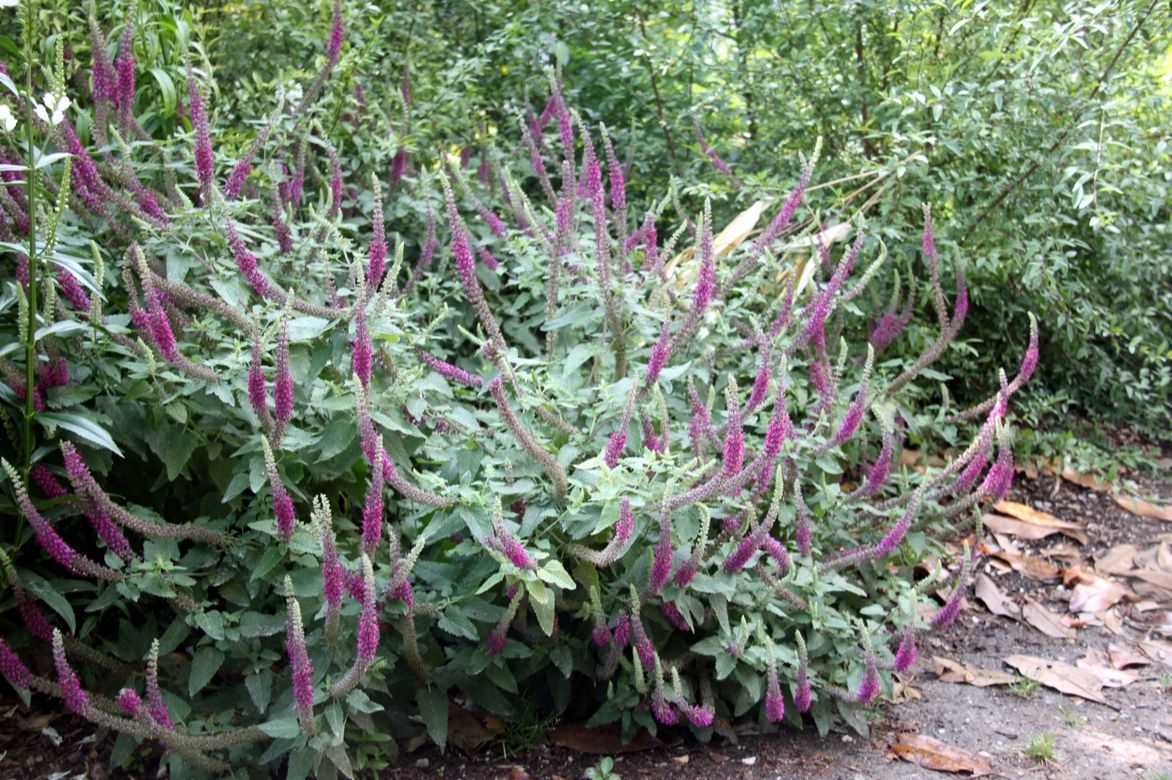
Multiplication
The germander is easily propagated in June by herbaceous cuttings or semi-ripe cuttings in July-August, by sowing in spring with mature seeds harvested in autumn from the garden, or by layering for shrub species, a more laborious operation.
Taking cuttings of Teucrium
- Take heel cuttings 5 to 10 cm long
- Remove the leaves from the lower half of the stem
- Insert the cuttings two-thirds into a tray or pots in a well-draining mix of equal parts potting soil and sand
- Keep in partial shade and water regularly until rooting, which is quite rapid
- In winter, protect the cuttings from frost in a cold frame
- Transplant in the following spring
- Pinch the young shoots to encourage bushiness
- Water well during the first year after planting
Sowing
- Under cover in February-March, sow the seeds in a tray containing good seed compost and sand
- Lightly cover the seeds with compost
- Firm down and keep moist until germination
- Keep the seedlings in light
- Transplant the seedlings into individual pots when they are strong enough to handle
- Plant in the ground when temperatures rise
- Pinch the young stems to encourage branching
By layering
- In spring, lower a low branch
- Remove the leaves from this part of the stem
- Lay it in a mix of garden soil, turf, and sand
- Bury it to encourage rooting
- In September, cut the rooted layers using pruning shears
- Transplant each shoot into a pot, in a mix of potting soil and sand
- Store throughout winter in a cold frame
- In the following spring, plant in the garden in well-drained soil
Associate germander with the garden
The germander is a plant well-suited to long periods of heat and naturally finds its place in dry gardens and natural gardens where the sun reigns supreme, in a scree garden or rockery alongside drought-tolerant plants and other Mediterranean perennials.
Teucrium fruticans, with its somewhat bushy appearance, thrives in free or trimmed hedges alongside summer-flowering bushes as frugal as itself: Escallonia, Vitex, Australian rosemary, Cistus, Althea. In a natural border, a beautiful, lush summer scene can be created by pairing it with shrubby lavateras, Caryopteris, hollyhocks, drought-tolerant euphorbias, Achillea millefolium, nepeta, and a few clumps of Stipa tenuifolia and Stipa pennata. The silvery foliage of Teucrium frutican ‘Azureum’ will resonate with the beautiful grey foliage of Artemisia, santolines, or Helichrysum italicum.
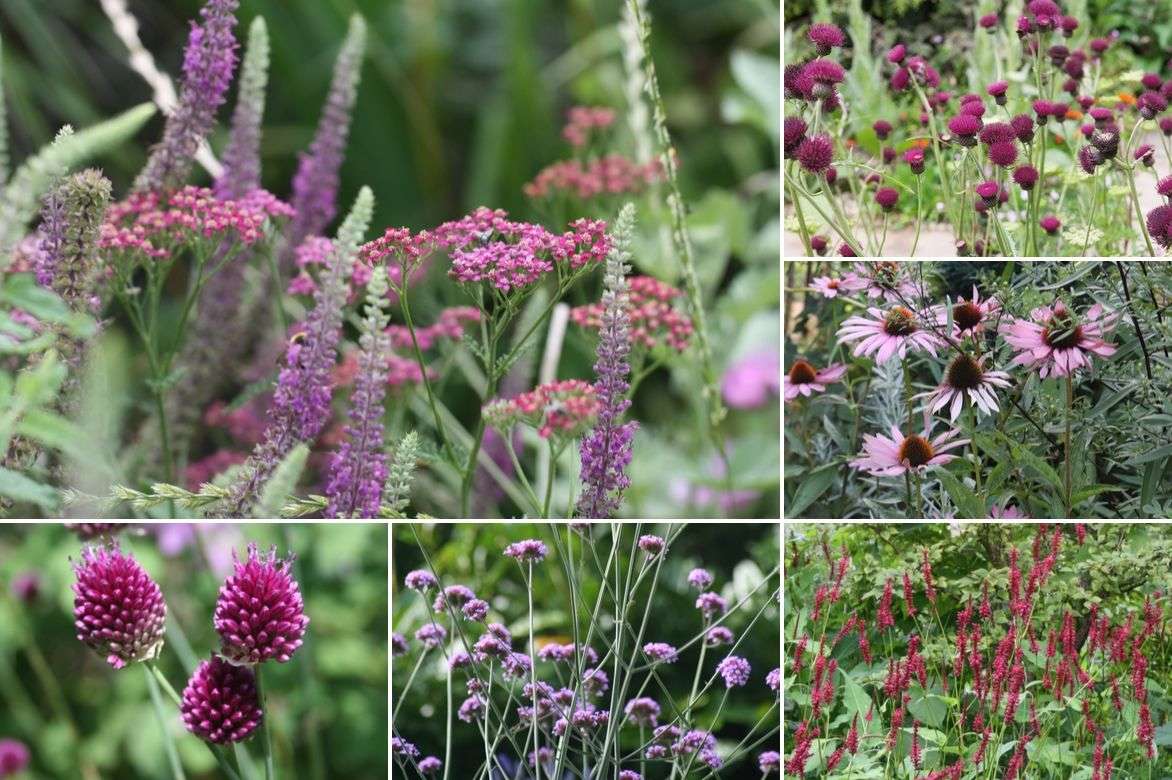
An example of a natural association: Teucrium hircanicum and Achillea ‘Cerise Queen’, Cirsium rivale ‘Atropurpurea’, Echinacea purpurea, Persicaria amplexicaulis ‘Blackfield’, Verbena bonariensis, and Allium sphaerocephalon
In a rockery reminiscent of garrigue, small germanders will accompany other low-maintenance, drought-tolerant plants such as creeping rosemary, Helichrysum petiolare, Perovskia, woody thymes, sage, small potentillas, and orpins.
They will also form lovely aromatic borders, paired with lavenders. The blue or violet flowers of germanders pair well with small hardy geraniums or Echinops ritro and will offer a lovely contrast with the complementary yellow flowers of coreopsis and helianthemums.
Creeping species can also cover the base of ceanothus or buddleias and Mediterranean shrubs such as creeping broom, olive, mimosa, cistus, and lantanas like those of small drought-tolerant shrubs such as Hertia cheirifolia and Hypericum olympicum.
→ Discover more ideas for associating Teucrium in our advice sheet!
Useful resources
- Discover our different varieties of Teucrium as well as a small selection of drought-resistant perennials, ideal for gardens without watering!
- What to plant in stony soil?
- All our plants for dry gardens
- Which plants for a sunny natural garden?
- Subscribe!
- Contents
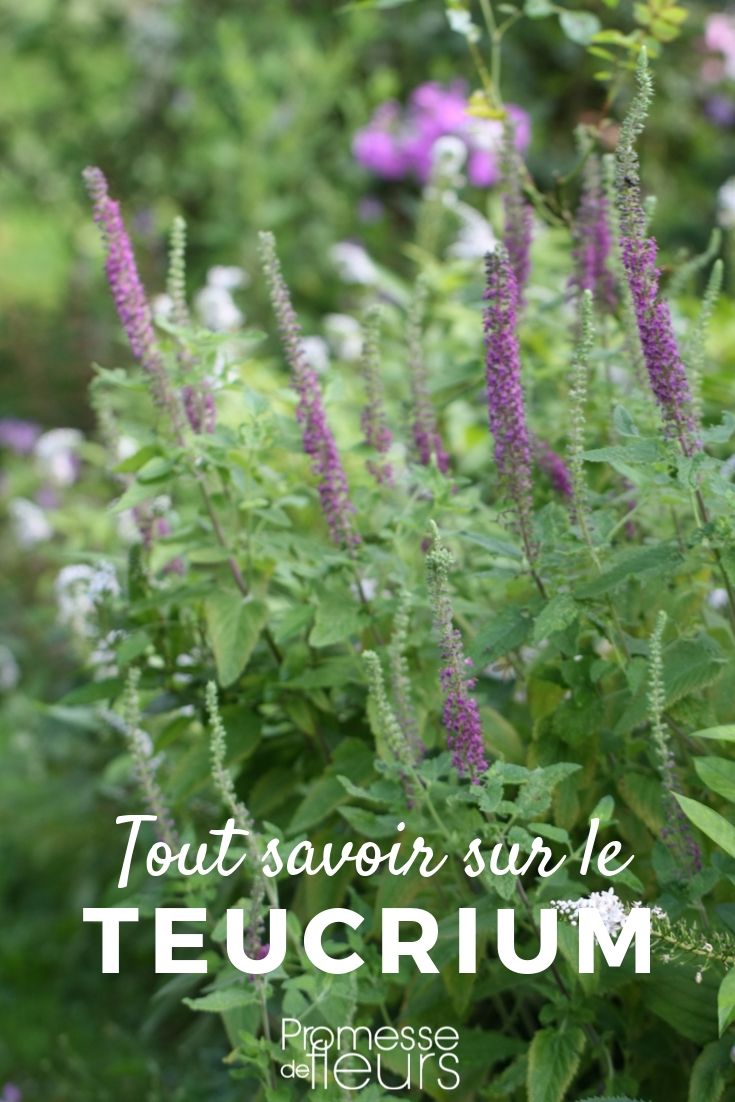
































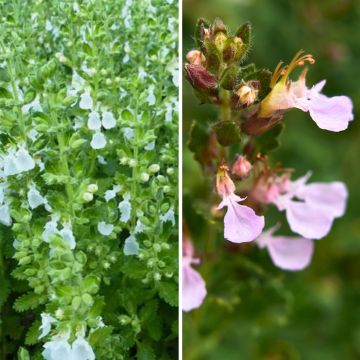



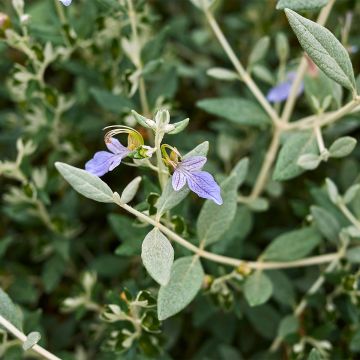


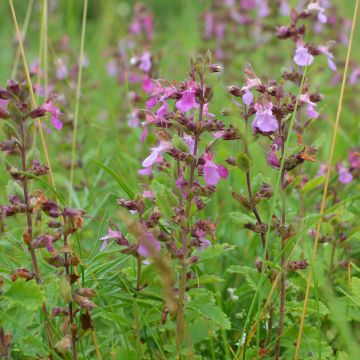

Comments